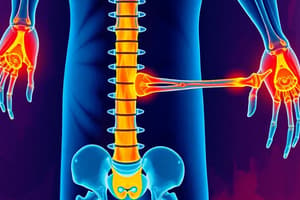Podcast
Questions and Answers
Which of the following is true about non-parametric tests?
Which of the following is true about non-parametric tests?
- Non-parametric tests have no assumptions.
- Non-parametric tests are used when data is normally distributed.
- Non-parametric tests are used when assumptions for parametric tests are violated. (correct)
- Non-parametric tests have more statistical power than parametric tests.
What is the Spearman correlation coefficient used for?
What is the Spearman correlation coefficient used for?
- Assessing the strength of a monotonic relationship between two variables. (correct)
- Assessing the strength of a non-linear relationship between two variables.
- Assessing the strength of a linear relationship between two variables.
- Assessing the strength of a normal distribution between two variables.
What does it mean for a relationship between two variables to be monotonic?
What does it mean for a relationship between two variables to be monotonic?
- The relationship is always linear.
- The relationship is always positive.
- The relationship is always negative.
- The relationship consistently increases or decreases. (correct)
True or false: Non-parametric tests have more statistical power than parametric tests.
True or false: Non-parametric tests have more statistical power than parametric tests.
True or false: The Spearman correlation coefficient works on the ranks of data, unlike the Pearson correlation.
True or false: The Spearman correlation coefficient works on the ranks of data, unlike the Pearson correlation.
True or false: Monotonic relationship means that the pairs of data consistently increase or decrease when ordered.
True or false: Monotonic relationship means that the pairs of data consistently increase or decrease when ordered.
Match the following non-parametric tests and their descriptions:
Match the following non-parametric tests and their descriptions:
Match the following symbols and their representations in Spearman correlation:
Match the following symbols and their representations in Spearman correlation:
Match the following assumptions and the tests they apply to:
Match the following assumptions and the tests they apply to:
Flashcards are hidden until you start studying




